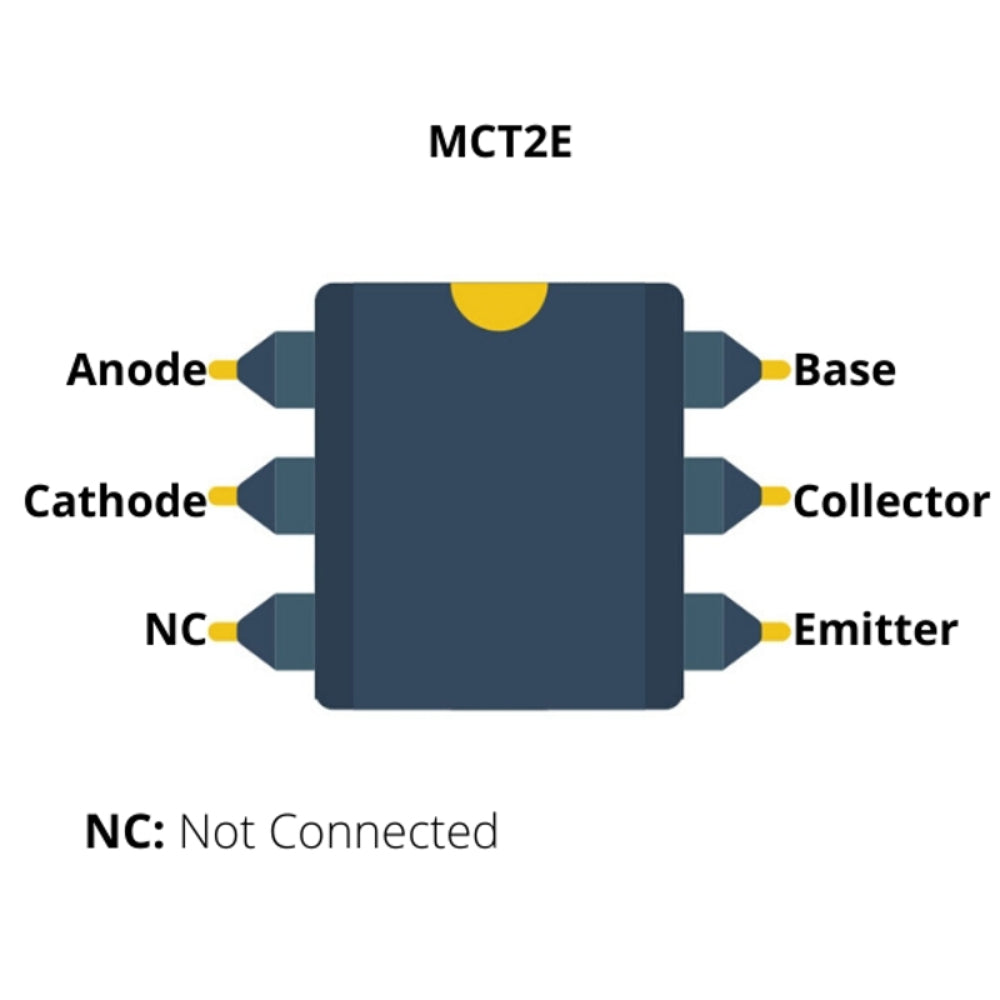Product Description (Detailed):
Achieve robust electrical isolation and secure signal transfer in your electronic designs with the MCT2E Optocoupler IC. Housed in a standard DIP-6 package, this essential component features an infrared LED on the input side and a phototransistor output on the isolated side, effectively bridging two circuits without direct electrical connection. This galvanic isolation is crucial for protecting sensitive low-voltage circuitry, such as microcontrollers, from high-voltage transients, ground loops, and electrical noise originating from power circuits or external interference.
The MCT2E is widely recognized for its reliability and general-purpose applications. When current flows through the input LED, it emits infrared light, which then activates the internal NPN phototransistor. This allows current to flow through the output side, effectively transferring the signal. This mechanism makes it ideal for a variety of critical functions, including microcontroller I/O switching circuits, where it isolates digital logic from higher voltage or noisy environments. It's also extensively used in AC/DC power control, switch mode power supply (SMPS) feedback loops, telephone ring detection, and general signal isolation to prevent noise propagation. With a typical high isolation voltage of 5300 VRMS, the MCT2E ensures a secure barrier between input and output. Its fast response time and stable performance across a wide operating temperature range (-55°C to +100°C) make it a versatile choice for industrial controls, home automation, and various DIY electronics projects. Simplify your design, enhance safety, and ensure signal integrity by integrating the dependable MCT2E Phototransistor Output Optocoupler into your circuits.
The MCT2E Optocoupler IC is a photo-isolator designed to transfer digital signals across an isolation barrier using infrared light. It contains an IR LED optically coupled to a phototransistor housed in a standard 6-pin DIP package.
This IC is widely used to protect microcontrollers from high-voltage or noisy circuits, such as switching relays, AC line detection, or industrial controllers. It’s ideal for Arduino and embedded system projects where safety and signal isolation are required.
The MCT2E enables safe communication between two circuits without a direct electrical connection, reducing the risk of component damage due to ground loops or voltage spikes.
Key Features:
-
Built-in infrared LED and phototransistor pair
-
Provides electrical isolation between input and output
-
Ideal for microcontroller signal isolation, relay driving, and zero-cross detection
-
Compact DIP-6 package for easy PCB mounting
-
Compatible with Arduino, Raspberry Pi, and STM32 boards
-
Fast switching and high reliability
Technical Specifications:
| Parameter |
Specification |
| Input LED Forward Voltage |
1.2V typical @ 10mA |
| Collector-Emitter Voltage (VCE) |
30V |
| Isolation Voltage |
5,300V RMS |
| Current Transfer Ratio (CTR) |
20% to 300% (depending on LED current) |
| Output Type |
NPN Phototransistor |
| Max Collector Current |
50mA |
| Package Type |
DIP-6 (dual inline) |
| Operating Temperature Range |
-55°C to +100°C |
How to Use:
-
Connect the anode and cathode of the internal LED (pins 1 and 2) to your low-voltage digital circuit (e.g., Arduino pin through a resistor).
-
Connect the collector and emitter (pins 4 and 5) to the external high-voltage side or load, using pull-up or base biasing as needed.
-
Ensure the LED side and transistor side are completely electrically isolated.
Example: Use MCT2E to switch a transistor/relay on the AC side while keeping your microcontroller safe.
Applications:
-
Digital signal isolation in embedded systems
-
Switching circuits and relay drivers
-
Zero-cross detection in AC circuits
-
Industrial automation and control systems
-
Arduino and Raspberry Pi GPIO protection
-
Noise isolation between logic levels and power electronics
Package Includes:
























